
Beta Lyrae officially named Sheliak, the traditional name of the system, is a multiple star system in the constellation of Lyra. Based on parallax measurements obtained during the Hipparcos mission, it is approximately 960 light-years distant from the Sun.

Westerlund 2 is an obscured compact young star cluster in the Milky Way, with an estimated age of about one or two million years. It contains some of the hottest, brightest, and most massive stars known. The cluster resides inside a stellar breeding ground known as Gum 29, located 20,000 light-years away in the constellation Carina. It is half a degree from the naked eye Cepheid variable V399 Carinae.

Westerlund 1 is a compact young super star cluster about 3.8 kpc away from Earth. It is thought to be the most massive young star cluster in the Milky Way, and was discovered by Bengt Westerlund in 1961 but remained largely unstudied for many years due to high interstellar absorption in its direction. In the future, it will probably evolve into a globular cluster.
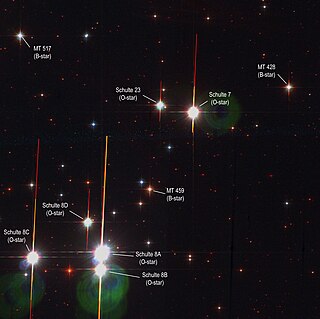
Cygnus OB2 #8A is a double-lined spectroscopic binary located near the centre of the Cygnus OB2 association located 5,500 light years away.
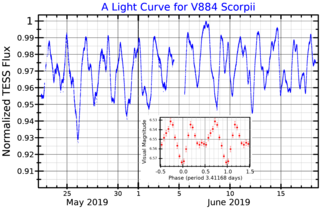
4U 1700-37 is one of the stronger binary X-ray sources in the sky, and is classified as a high-mass X-ray binary. It was discovered by the Uhuru satellite. The "4U" designation refers to the fourth Uhuru catalog.

HD 150136 is a multiple star system in the southern constellation of Ara, around 4,300 light years away. It is the brightest member of the faint open cluster NGC 6193, part of the Ara OB1 association.
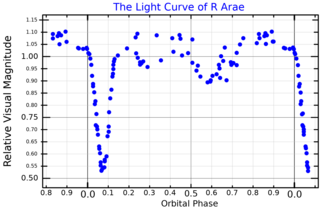
R Arae is an Algol-type eclipsing binary in the constellation Ara. Located approximately 298 parsecs (970 ly) distant, it normally shines at magnitude 6.17, but during eclipses can fall as low as magnitude 7.32. It has been suggested by multiple studies that mass transfer is occurring between the two stars of this system, and the period of eclipses seems to be increasing over time. The primary is a blue-white main sequence star of spectral type B5V that is 5 times as massive as the Sun, while the secondary is a yellow-white star of spectral type F1IV that is 1.5 times as massive as the Sun. Stellar material is being stripped off the secondary and accreting on the primary.

WR 22, also known as V429 Carinae or HR 4188, is an eclipsing binary star system in the constellation Carina. The system contains a Wolf-Rayet (WR) star that is one of the most massive and most luminous stars known, and is also a bright X-ray source due to colliding winds with a less massive O class companion. Its eclipsing nature and apparent magnitude make it very useful for constraining the properties of luminous hydrogen-rich WR stars.

WR 25 is a binary star system in the turbulent star-forming region the Carina Nebula, about 6,800 light-years from Earth. It contains a Wolf-Rayet star and a hot luminous companion and is a member of the Trumpler 16 cluster. The name comes from the Catalogue of Galactic Wolf–Rayet Stars.

V3903 Sagittarii is an eclipsing binary star system in the constellation Sagittiarus. It creates an H II region LBN 29 1,070 parsecs away from the Sun.
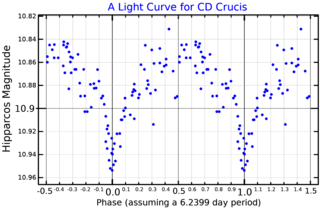
CD Crucis, also known as HD 311884, is an eclipsing binary star system in the constellation Crux. It is around 14,000 light years away near the faint open cluster Hogg 15. The binary contains a Wolf–Rayet star and is also known as WR 47.

HD 15558 is a massive O-type multiple star system in Cassiopeia and is specifically in our galaxy's Heart Nebula in open cluster IC 1805. The primary is a very massive star with 152 M☉ and 660,000 L☉.
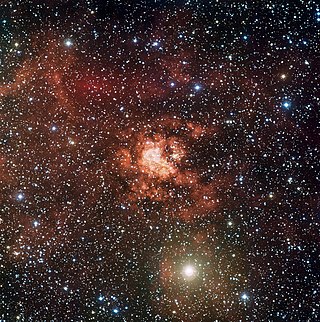
WR 21a is an eclipsing binary star in the constellation Carina. It includes one of the most massive known stars and is one of the most massive binaries.

Westerlund 1-20 (abbreviated to Wd 1-20 or just W20) is a red supergiant (RSG) located in the Westerlund 1 super star cluster. Its radius was calculated to be around 965 solar radii (6.72 × 108 km, 4.48 au), making it one of the largest stars discovered so far. This corresponds to a volume 899 million times bigger than the Sun. If placed at the center of the Solar System, the photosphere of Westerlund 1-20 would almost reach the orbit of Jupiter.

Westerlund 1-75 or Wd 1-75 is a red supergiant (RSG) located in the Westerlund 1 super star cluster. Its radius is calculated to be around 668 solar radii (4.65 × 108 km, 3.10 au). This corresponds to a volume 298 million times bigger than the Sun. If placed at the center of the Solar System, Westerlund 1-75 would engulf the inner limits of the asteroid belt.
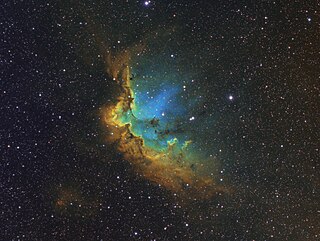
DH Cephei is a variable binary star system in the northern circumpolar constellation of Cepheus, positioned about two degrees to the east of the star system Delta Cephei. With an apparent visual magnitude of 8.61, it is too faint to be visible without a telescope. Based on parallax measurements, this system is located at a distance of approximately 9.6 kilolight-years from the Sun. At present it is moving closer to the Earth with a radial velocity of −33 km/s.

Westerlund 1-243 or Wd 1-243 is a luminous blue variable (LBV) star undergoing an eruptive phase located within the outskirts of the super star cluster Westerlund 1. Located about 13,400 ly (4,100 pc) from Earth, it has a luminosity of 0.73 million L☉ making it one of the most luminous stars known.
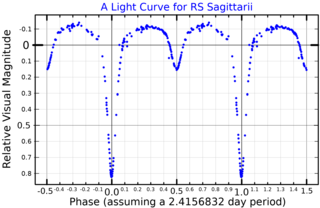
RS Sagittarii is an eclipsing binary star system in the southern constellation of Sagittarius, abbreviated RS Sgr. It is a double-lined spectroscopic binary with an orbital period of 2.416 days, indicating that the components are too close to each other to be individually resolved. The system has a combined apparent visual magnitude of 6.01, which is bright enough to be faintly visible to the naked eye. During the primary eclipse the brightness drops to magnitude 6.97, while the secondary eclipse is of magnitude 6.28. The distance to this system is approximately 1,420 light years based on parallax measurements.
















